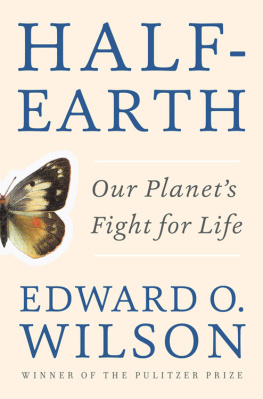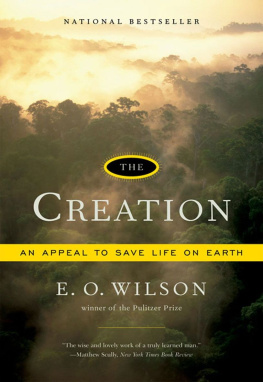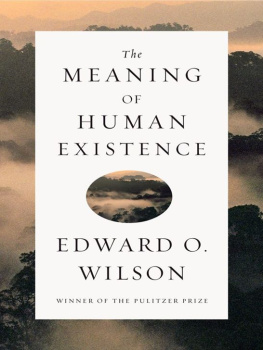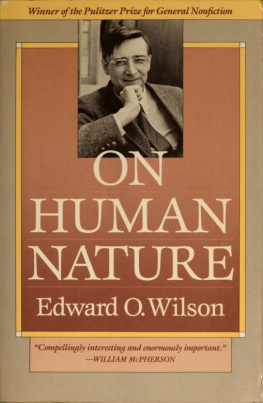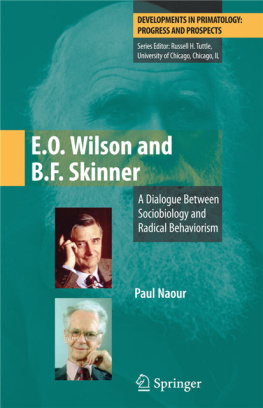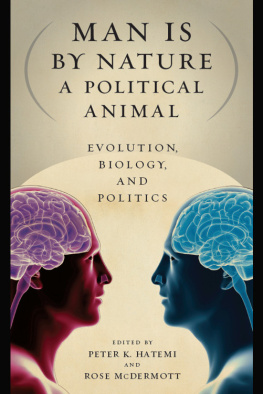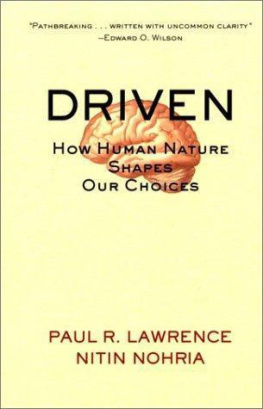Sociobiology
By the Same Author
Biological Diversity: The Oldest Human Heritage
Consilience: The Unity of Knowledge
In Search of Nature
Biodiversity II: Understanding and Protecting Our Natural Resources
co-editor with Marjorie L. Reaka-Kudla and Don E. Wilson
Naturalist
Journey to the Ants
with Bert Hlldobler
The Biophilia Hypothesis
co-editor with Stephen R. Kellert
The Diversity of Life
Success and Dominance in Ecosystems: The Case of the Social Insects
The Ants
with Bert Hlldobler
Biodiversity
editor
Biophilia
Promethean Fire
with Charles J. Lumsden
Genes, Mind, and Culture
with Charles J. Lumsden
Caste and Ecology in the Social Insects
with George F. Oster
On Human Nature
The Insect Societies
A Primer of Population Biology
with William H. Bossert
The Theory of Island Biogeography
with Robert H. MacArthur
Sociobiology
THE NEW SYNTHESIS
Edward O. Wilson
Twenty-Fifth Anniversary Edition
The Belknap Press of Harvard University Press
Cambridge, Massachusetts, and London, England
Copyright 1975, 2000 by the President and Fellows of Harvard College
All rights reserved
Printed in the United States of America
Library of Congress Cataloging-in-Publication Data
Wilson, Edward Osbourne, 1929
Sociobiology: the new synthesis /Edward O. Wilson.25th anniversary ed.
p. cm.
Includes bibliographical references (p.)
ISBN 0-674-00089-7ISBN 0-674-00235-0 (pbk.)
1. Social behavior in animals. 2. Sociobiology. I. Title.
QL775.W54 2000
591.56dc21 99-044307
Sociobiology at Centurys End
Sociobiology was brought together as a coherent discipline in Sociobiology: The New Synthesis (1975), the book now reprinted, but it was originally conceived in my earlier work The Insect Societies (1971) as a union between entomology and population biology. This first step was entirely logical, and in retrospect, inevitable. In the 1950s and 1960s studies of the social insects had multiplied and attained a new but still unorganized level. My colleagues and I had worked out many of the principles of chemical communication, the evolution and physiological determinants of caste, and the dozen or so independent phylogenetic pathways along which the ants, termites, bees, and wasps had probably attained advanced sociality. The idea of kin selection, introduced by William D. Hamilton in 1963, was newly available as a key organizing concept. A rich database awaited integration. Also, more than 12,000 species of social insects were known and available for comparative studies to test the adaptiveness of colonial life, a great advantage over the relatively species-poor vertebrates, of which only a few hundred are known to exhibit advanced social organization. And finally, because the social insects obey rigid instincts, there was little of the interplay of heredity and environment that confounds the study of vertebrates.
During roughly the same period, up to 1971, researchers achieved comparable advances in population biology. They devised richer models of the genetics and growth dynamics of populations, and linked demography more exactly to competition and symbiosis. In the 1967 synthesis The Theory of Island Biogeography, Robert H. MacArthur and I (if you will permit the continued autobiographical slant of this account) meshed principles of population biology with patterns of species biodiversity and distribution.
It was a natural step then to write The Insect Societies at the close of the 1960s as an attempt to reorganize the highly eclectic knowledge of the social insects on a base of population biology. Each insect colony is an assemblage of related organisms that grows, competes, and eventually dies in patterns that are consequences of the birth and death schedules of its members.
And what of the vertebrate societies? In the last chapter of The Insect Societies, entitled The Prospect for a Unified Sociobiology, I made an optimistic projection to combine the two great phylads:
In spite of the phylogenetic remoteness of vertebrates and insects and the basic distinction between their respective personal and impersonal systems of communication, these two groups of animals have evolved social behaviors that are similar in degree and complexity and convergent in many important details. This fact conveys a special promise that sociobiology can eventually be derived from the first principles of population and behavioral biology and developed into a single, mature science. The discipline can then be expected to increase our understanding of the unique qualities of social behavior in animals as opposed to those of man.
The sequel in this reasoning is contained in the book before you. Presented in this new release by Harvard University Press, it remains unchanged from the original. It provides verbatim the first effort to systematize the consilient links between termites and chimpanzees, the goal suggested in The Insect Societies, but it goes further, and extends the effort to human beings.
The response to Sociobiology: The New Synthesis in 1975 and the years immediately following was dramatically mixed. I think it fair to say that the zoology in the book, making up all but the first and last of its 27 chapters, was favorably received. The influence of this portion grew steadily, so much so that in a 1989 poll the officers and fellows of the international Animal Behavior Society rated Sociobiology the most important book on animal behavior of all time, edging out even Darwins 1872 classic, The Expression of the Emotions in Man and Animals. By integrating the discoveries of many investigators into a single framework of cause-and-effect theory, it helped to change the study of animal behavior into a discipline connected broadly to mainstream evolutionary biology.
The brief segment of Sociobiology that addresses human behavior, comprising 30 out of the 575 total pages, was less well received. It ignited the most tumultuous academic controversy of the 1970s, one that spilled out of biology into the social sciences and humanities. The story has been told many times and many ways, including the account in my memoir, Naturalist, where I tried hard to maintain a decent sense of balance; and it will bear only a brief commentary here.
Although the large amount of commotion may suggest otherwise, adverse critics made up only a small minority of those who published reviews of Sociobiology. But they were very vocal and effective at the time. They were scandalized by what they saw as two grievous flaws. The first is inappropriate reductionism, in this case the proposal that human social behavior is ultimately reducible to biology. The second perceived flaw is genetic determinism, the belief that human nature is rooted in our genes.
It made little difference to those who chose to read the book this way that reductionism is the primary cutting tool of science, or that Sociobiology stresses not only reductionism but also synthesis and holism. It also mattered not at all that sociobiological explanations were never strictly reductionist, but interactionist. No serious scholar would think that human behavior is controlled the way animal instinct is, without the intervention of culture. In the interactionist view held by virtually all who study the subject, genomics biases mental development but cannot abolish culture. To suggest that I held such views, and it was suggested frequently, was to erect a straw manto fabricate false testimony for rhetorical purposes.
Next page

